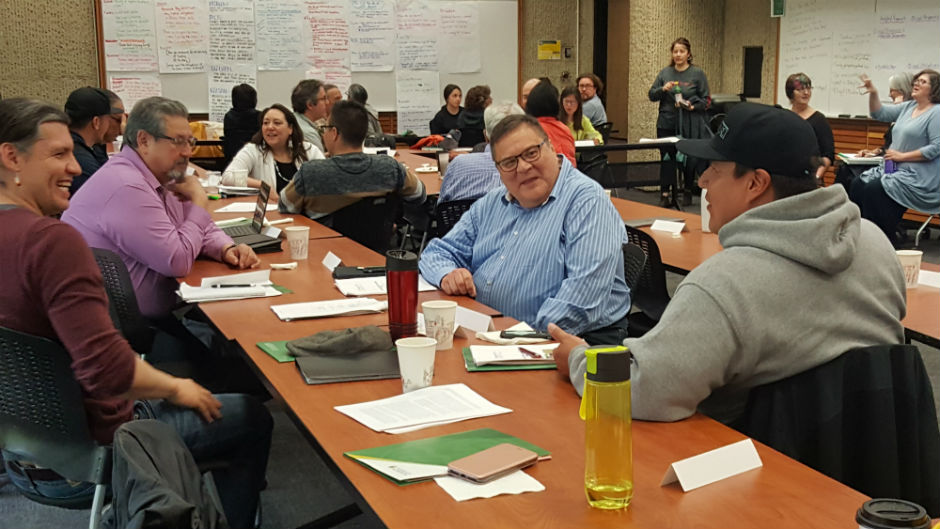
The Wahkohtowin Law and Governance Lodge workshop attracted more than 40 participants.
With a hands-on, eye-opening workshop in which participants learned the basic steps of two methods for identifying and working with Indigenous law and governance principles, the University of Alberta's Wahkohtowin Law and Governance Lodge officially launched late last month.
The lodge is a major collaboration between the Faculty of Native Studies and the Faculty of Law, supported by an initial two-year grant from the Alberta Law Foundation. The initiative was developed and is co-led by Shalene Jobin, Associate Professor, Faculty of Native Studies, and Hadley Friedland, Assistant Professor, Faculty of Law. It was created in the spirit of Call to Action #50 from the "Final Report of the Truth and Reconciliation Commission of Canada," and in response to community demand for an academic centre to support building Indigenous law and governance through community-led collaborative research and engagement.
The workshop attracted more than 40 participants, including members from 10 Alberta Indigenous communities and organizations, lawyers, prominent Indigenous legal scholars, a Federal Court justice, law professors and students. They met at the Law Centre May 23-25, and worked through exercises designed to identify the underlying concepts of law from Indigenous stories.
At the heart of the two-and-a-half day workshop, small groups each took a different but well-known Cree story that explored an age-old problem of human behaviour and revealed the Indigenous community's solution within the tale. From each story, the group created a mini case brief similar to those which are the building blocks of Canadian case law. Next they brought these all together for an analysis of the overall legal area.
"It was very helpful to identify the problem and then learn how to apply the procedure for restorative justice," said Clara Moberly, a former council member form the Bigstone Cree Nation in Wabasca, who took part in the workshop.
"The overwhelming participant feedback was how helpful the workshop was to Indigenous communities and how there is a strong desire to have more in the future," said Jobin. "I see this as a very positive beginning that we plan to build on."
The methods used in analyzing the stories included the Indigenous Law Research Unit Method (ILRU) that was co-developed by Val Napoleon, Law Foundation Chair of Aboriginal Justice and Governance, and director of the ILRU at the University of Victoria, and Friedland, who was the first research director of the ILRU. Both helped lead the workshop with Jobin and Rebecca Johnson, UVic professor and Associate Director of the ILRU.
Participants also learned about the Indigenous Governance and Partnership Program Method (IGP) which Jobin developed at UAlberta and has successfully used to support Indigenous governments' goals for a decade.
Friedland and Jobin view the IGP Method as complementing the ILRU Method by incorporating a review of community-specific background information and literature about current governance structures. It also addresses the fuller scope of governance and facilitates broader skill development within partner communities.
"This is the most exciting work taking place on the planet," said Napoleon, referring to what she called a hunger for information by Indigenous people in countries worldwide, about how to learn and apply Indigenous laws in their Indigenous communities and beyond.
"It's sharing our questions and figuring out ways to be conversational with each other," she said.
The workshop opened with the establishment of several grounding principles. First and foremost, Indigenous laws need to be treated as laws. As well, the research methods need to be rigorous and transparent, Indigenous law is to be understood as only one aspect of governance, but incorporating it is essential for reconciliation to work and for building healthy Indigenous communities.
Before the participants began learning about the methodology, they were invited to anonymously post short statements of their experiences as Indigenous People, in an activity known as a Tully Wheel, which both acknowledges and organizes memories. Some of the statements were stark and heartbreaking, ranging from accounts of daily racism, to a short story about a parent whose life was irrevocably broken by her mistreatment in a residential school. Other statements were inspiring, as people shared ways they have resisted oppression and taken action to build healthy lives, relationships and communities.
Wahkohtowin Law and Governance Lodge fellows and graduate students also shared brief examples of how they have applied these and other methods to various issues ranging from Cree environmental law (Darcy Lindberg), urban homelessness strategies (Renée Beausoleil), employment policies for First Nation businesses (Johanne Johnson), gender dynamics within Cree law (Emily Snyder) to uniting First Nations to develop a shared education authority (Matt Wildcat).
"These scholars' work show some of the scope and breadth of work already happening," said Friedland. "Part of the WLGL's vision is to bring together scholars and communities working in diverse ways on diverse issues to learn from one another and continue to develop resources in this field."